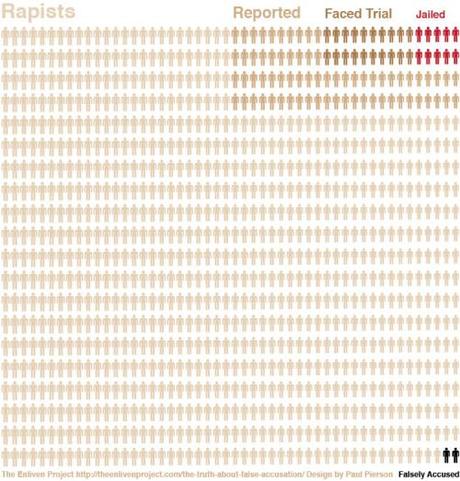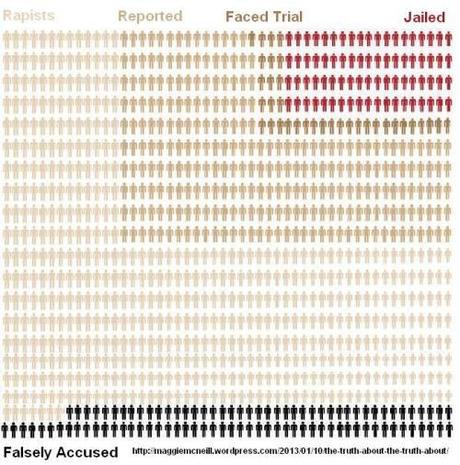It is the essence of truth that it is never excessive…we must not resort to the flame where only light is required. - Victor Hugo
I’m sure many of you saw this “infographic” earlier this week:
It was passed all over the internet by well-meaning people with sonorous pronouncements about “rape culture”, and nobody bothered to ask the obvious question: If all those rapes are unreported, how do we know about them? Furthermore, what statistics did the compilers use to determine how many are false? The thing defies both facts and logic, and because it’s politically incorrect to question anything feminists say about rape, virtually nobody challenged it. I criticized it Monday on Twitter and was considering how I might go about debunking it, then law blogger Mark Bennett saved me a great deal of trouble:
…The numbers, particularly the last one—only two false accusations for every 100 true reports—are very interesting to me. Where did the illustrator get them? According to Sarah Beaulieu, who published it, “Statistics from Justice Department, National Crime Victimization Survey: 2006-2010 and FBI reports.” Sounds good. But wait: “…This infographic…combines data from several sources, both domestic and international…Some reports suggest that only 5-25% of rapes are reported to authorities. Other suggest that close to half are reported. We assumed 10%, which is dramatic, but possible. Of the rapes that are reported, approximately 9 are prosecuted..[and] 5 result in felony convictions…Assuming that 2% of reported rapes are false…” No links, nothing. We have to trust Beaulieu that this is what the statistics show…
Of those reported cases, how many are prosecuted (“faced trial”)? Nine?…The infographic shows 30% of the reported cases being prosecuted, assuming that someone has to be prosecuted to be jailed…[it also shows] that 1/3 of rapists who face trial are jailed…[which also] does not match the number provided…If you assumed, instead, that Harris County [Texas] is typical, you would find that in 2012, 172 sexual-assault-of-an-adult cases ended in dismissal or acquittal, and 382 ended in conviction or deferred-adjudication probation—2/3 held responsible, near as dammit…Finally, where does the 2% number come from?…You can find a bigger and more credible number, 5.9%, here—certainly not a hotbed of rape apologists…If you wanted a credible reason to assume that the number was even bigger—25%—you could find it here: “Forensic DNA typing laboratories…encounter rates of exclusion of suspected attackers in close to 25 percent of cases…”
Since I believe in statistics more than some supposed moral and psychological superiority of my own sex, I find 25% to be a far more credible number than 2%. People seem to imagine that the term “false accusation” implies malice, but it does not; while some fraction of false accusations are undoubtedly malicious, a far larger fraction result from panic at being caught in illicit sex by parents or boyfriends, and the largest fraction by far are almost certainly incorrect identifications arising from trauma and suggestion or even pressure from cops and prosecutors. And while people can lie, DNA doesn’t; if a properly-conducted test excludes a suspect he was falsely accused, no matter what rape panic-mongers may claim.
As for that “only 10% of rapes are reported” nonsense, I call your attention to Mary Koss and other “researchers” like her, who not only use absurdly-broad definitions but also ignore the opinions of the women they survey. Only 27% of the women Koss labeled “rape victims” agreed that they had indeed been raped, and 42% of them later chose to have sex with their “rapists” again; later “studies” produce similar (or even lower) results, so I think it’s fair to presume that only 27% of the “rapes” on that “infographic” would actually be called rapes by the victims (or anyone else without an agenda to advance). For the sake of simplicity I’m going to assume that all of the reported rapes were perceived as such by the victims (though that may not be so); furthermore, since a criminal defense attorney found no fault with the 30% prosecution figure I won’t, either. Finally, I’m going to use Bennett’s Texas conviction rate; the final “infographic” looks like this: 
I think we can all agree that mine looks a lot more like something that might occur in the real world, and less like something dreamed up in the fearful, hate-poisoned minds of neofeminists. Exaggerating the number of rapes and downplaying the number of convictions and false accusations does not help rape victims; it undermines their credibility and thus makes it much harder for women who aren’t “perfect victims” (such as sex workers) to report real and sometimes violent rape.
